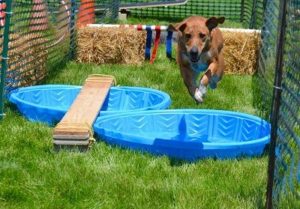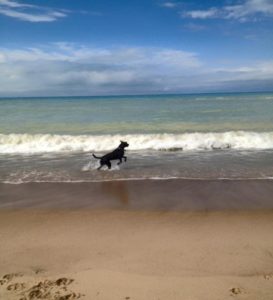 We adopted our dog when he was eight months old. I recall seeing a dry erase board in the hallway of the shelter during our visit with him. On the board were written the names of adoptable dogs and underneath there were brief descriptions of the dogs’ personalities. Underneath our dog’s name was written “A little humpy, a little jumpy.” In person, they described him as “energetic.” We were, of course, already in love at that point, so we figured we could handle a little puppy energy.
We adopted our dog when he was eight months old. I recall seeing a dry erase board in the hallway of the shelter during our visit with him. On the board were written the names of adoptable dogs and underneath there were brief descriptions of the dogs’ personalities. Underneath our dog’s name was written “A little humpy, a little jumpy.” In person, they described him as “energetic.” We were, of course, already in love at that point, so we figured we could handle a little puppy energy.
We assumed this “energetic” stage would be just that – a stage. We were a little naïve then.
This dog literally bounced off the walls. He cleared five foot fences with ease (and without remorse). He hurled all seventy pounds of himself at strangers who came to the door. He howled and yelped to go outside constantly. On a leash, he pulled and jerked about with every fiber of his being. I once watched him swim in Lake Monroe for two hours straight without touching land.
We gritted our teeth and exercised him and took him to obedience classes. We read up on “high energy” breeds. We waited for this “energetic” stage to pass. And we waited. And waited.
Four years later, we finally have the relationship with our dog that we’d always wanted. I’d like to be able to say that this is because our dog has finally “calmed down,” but we’ve long since come to accept that this “energetic” stage is simply a part of his personality. Our dog hasn’t changed drastically over the years, but we have learned to alter our own routines in ways that allows all of us to be happy.
If you have a “high energy” or “rambunctious” dog, these are the tips I have learned over the years to strengthen your relationship and keep everybody sane.
- Regular Exercise. Fifteen minutes of walking on a leash every day is simply not going to cut it for certain dogs. Not only will regular exercise keep your dog from bouncing off the walls, you will be amazed at how much better your dog listens to your commands after a good exercise session. Try taking up jogging with your pooch. Find an enclosed baseball diamond or soccer field and hit tennis balls or throw a Frisbee for your dog every evening. If your dog enjoys the company of other dogs, take her to the dog park every few days. Stuck inside on a rainy day? Incorporate
 stairs or other obstacles into a game of fetch in the house. Have an energetic and focused dog? Try a beginner’s agility class. Then, after your dog is a little tired, practice all of the great training tricks you’ve been working on, like “sit” and “down” and walking nicely on a leash.
stairs or other obstacles into a game of fetch in the house. Have an energetic and focused dog? Try a beginner’s agility class. Then, after your dog is a little tired, practice all of the great training tricks you’ve been working on, like “sit” and “down” and walking nicely on a leash. - Regular “relaxing” time in a safe place. This one took us a while to learn. We now have certain times of day where we expect our dog to go lay down and relax or entertain himself. During these times we mostly ignore him, except to let him outside or to provide a Kong or long-term chew treat. The key is practicing this with regularity, so that the dog knows to expect this “relaxing” time on a regular basis. We practice this while we are on our computers, which we keep in the same place and use at the same times every day. Now, as soon as we sit down at our desks, our dog curls up in his dog bed beside us and takes a nap. He will relax for up to eight hours at a time now, which we would have once thought to be impossible.
- Related to the previous tip, we practice the command “go to bed.” This is a command I learned in a “Rambunctious Dogs” class. You choose a specific dog bed where you want your dog to go relax for a while. Have them lie down in the bed and reward them. You introduce the “go to bed” command after they understand that they are supposed to go lie down. You gradually increase the amount of time you have them lie in the bed without whining or getting up. The goal is to be able to have the dog “chill out” on command. We also practice this when people come to the door.

- Re-directing attention. Sometimes the best tool you have at your disposal is distraction. If your dog is a jumper or a barker, you’ll need to find the trigger that causes them to go off. This may be the mailman, friends at the door, or other dogs. Try using a high-value reward to gain your dog’s attention when this situation arises, and then ask for a replacement behavior that they know well, such as “sit” or “down.” Practice this re-direction as often as possible. This can be hard work, but it is typically more effective than telling your dog to “quiet down” or “stop that” constantly.
- Avoiding situations that cause your dog to get over-stimulated. There are some dogs who, without the help of a professional trainer, may just be too reactive to certain situations for the typical owner to handle. Maybe your dog gets too excited when you have a lot of people over. It could be a good idea to crate the dog or keep him in a separate room if the amount of people is causing him to get overwhelmed or anxious. Another avoidance behavior we practice with our dog is called “let’s go.” We practice this regularly on our walks. When I give this command, we turn around and walk quickly in the opposite direction. We use this to avoid situations where I think he may be reactive to another dog in a way that I don’t feel like dealing with. This is less stressful for me, for my dog, and probably for the other owner as well.
 Having a high energy or rambunctious dog can sometimes be difficult, but those characteristics should not keep you from considering adoption. There are a lot of benefits to an active dog. My dog is a great jogging partner. He camps, hikes, and swims with us, which has helped us form a very special relationship with him. We never worry about his weight or other health problems associated with a sedentary lifestyle. He is still “a little humpy, a little jumpy” sometimes, but now we know what to do to re-direct his attention.
Having a high energy or rambunctious dog can sometimes be difficult, but those characteristics should not keep you from considering adoption. There are a lot of benefits to an active dog. My dog is a great jogging partner. He camps, hikes, and swims with us, which has helped us form a very special relationship with him. We never worry about his weight or other health problems associated with a sedentary lifestyle. He is still “a little humpy, a little jumpy” sometimes, but now we know what to do to re-direct his attention.
We’ve learned from our dog that maintaining a routine is the most important aspect to creating the lifestyle you want to have with your pet. All of us are happier, happier, and less rambunctious now that we know what to expect from each other.
